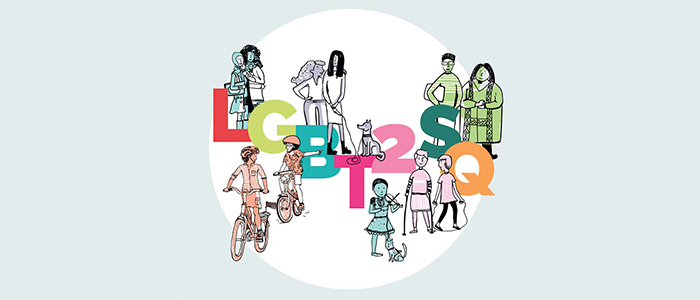We're moving content over from an older government website. We'll align this page with the ontario.ca style guide in future updates.
Serving LGBT2SQ children and youth in the child welfare system
Learn about how children’s aid societies, residential service providers and caregivers can better meet the needs of LGBT2SQ children and youth.

Why this guide is important
This resource guide has been developed to help children’s aid societies, residential service providers, and caregivers, for example: foster, kin, and customary caregivers better meet the needs of the LGBT2SQ children and youth they serve.
Many different acronyms are used to refer to the diverse communities of people who identify with a sexual orientation and/or gender identity that has been marginalized. In this guide, the acronym LGBT2SQ is used except when an acronym appears in a quote or reference from another source. The acronym LGBT2SQ refers to gender identities and sexual orientations including, but not limited to, lesbian, gay, bisexual, transgender, Two-Spirit, queer, and questioning. It is important to remember that terms used to describe gender identities and sexual orientations are always evolving. Other variations of the acronym may be ordered differently, for example: GLBT , LGBT2SQ , or include other letters to give visibility to identities, for example, intersex, asexual, that are not explicitly reflected in shorter acronyms, for example: LGBT2SQIA.
Whether child protection workers and caregivers are aware of it or not, it is very likely that some of the children and youth they serve identify as LGBT2SQ. While it is estimated that 10% of the general population is LGBT2SQ, studies suggest there is a much higher percentage of LGBT2SQ children and youth in the child welfare system because many LGBT2SQ children and youth face rejection, neglect or abuse when their families learn of their sexual orientation, gender identity, and/or gender expression.
An ally is someone who believes in the dignity and respect of all people and takes action by supporting and/or advocating with groups experiencing social injustice. An ally does not identify as a member of the group they are supporting, for example: a heterosexual person can act as an ally for gay people and communities; a cisgender lesbian can act as an ally for trans people and communities.
- Egale, 2017
Many LGBT2SQ children and youth also face challenges within the child welfare system. For example:
- difficulty finding a trusted person to be open with about their identity (e.g., an ally in whom to confide).
- lack of safe, welcoming placement options and permanent homes that affirm, and are inclusive of, LGBT2SQ identities.
- hostility, harassment, or violence from their peers in foster and group care settings that may go unchallenged by staff and caregivers.
- discipline for, and/or restriction of, age-appropriate behaviours that might be accepted between youth of different sexes and/or genders (e.g., dating).
- child protection workers and caregivers who lack awareness and understanding of the needs of LGBT2SQ children and youth and/or the resources available to support them.
- challenges developing lasting relationships or accessing appropriate services due to stigma and discrimination.
- lack of understanding by child welfare professionals of their roles in supporting families who may be struggling with their LGBT2SQ child or youth’s gender identity, gender expression, and/or sexual orientation
footnote 2 . - lack of specific LGBT2SQ inclusion policies and promising practices (e.g., placement related to gender identity, access to gender-affirming health care).
- not seeing themselves and other LGBT2SQ identities represented among workers, caregivers, and leaders.
Supportive adults and LGBT2SQ-affirming services can make a positive difference in the lives and longer term outcomes of LGBT2SQ children and youth. Staff, caregivers, and leaders in the child welfare system can play an important role in preventing and addressing these challenges by becoming LGBT2SQ allies.
Footnotes
- footnote[1] Back to paragraph U.S. Department of Health and Human Services: Child Welfare.; and Child Welfare Information Gateway: Supporting Your LGBTQ Youth: A Guide for Foster Parents.
- footnote[2] Back to paragraph Child Welfare League of America: Best Practice Guidelines: Serving LGBT Youth in Out of Home Care; and Ministry of Children and Youth Services: Blueprint for Fundamental Change to Ontario’s Child Welfare System.